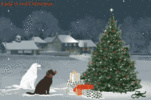HISTORY OF CHRISTMAS EVE
The tradition of celebrating Christmas Eve derives partly from Christan liturgy starting at sunset, which is inherited from Jewish tradition and based on the Book of Genesis’s Story of Creation, saying the first day starts in the evening and ends in the morning. It is also believed that Jesus, or Jesus of Nazareth, was born at midnight in the region of Palestine. Many historical conceptions on ancient traditions contributed to the development of eve celebrations, which persisted in the early Christian calendar.
Christmas Eve marks the end of the Advent season, the period of preparation for Christmas, which begins on November 30, or November 15 in the East. It was on this night that the shepherds keeping watch over their flocks outside Bethlehem saw the bright star in the sky that signaled the birth of Jesus Christ. This is why many churches have services beginning on the fourth Sunday before Christmas. From the 12th to the 15th century, due to the Holy Inquisition, Christian traditions were made mandatory. During the 16th century, the church was influenced by the Winter Solstice celebrations and began Christmas preparations the night prior.
In many parts of Europe, people believe that at midnight on Christmas Eve, animals briefly possess the power of speech. It might have been the traditional association of the ox and the donkey in the Nativity scene that gave rise to such superstitions, but the concept of talking animals is probably pagan in origin. A closely related belief, widespread in England and Europe, is that cattle rise in their stalls at midnight on Christmas Eve, or kneel to worship the Christ child.
Despite its Christian significance, there are a number of pagan and supernatural beliefs connected with Christmas Eve. In Scandinavian countries, it is believed that the dead revisit their former homes on Christmas Eve. People make sure that their parlors are tidy and that a good fire is burning before they go to bed. They often light candles, set the table, and leave out plenty of food for their ghostly visitors. They also make sure that the seats of their chairs have been dusted. When they get up in the morning, they wipe the chairs again with a clean white towel. If they find any dirt on the seat, it means that a relative fresh from the grave sat there during the night.
Celebrating Christmas as a holiday became popular in the 19th century. Christmas Eve remains an important part of Christian culture and signifies the birth of Jesus. It has become even more popular within the last century thanks to a beloved icon: Santa Claus. The idea of the jolly man in red gave rise to more traditions such as hanging stockings and leaving out cookies, milk, and sometimes carrots for his reindeer.
Apart from Santa Claus and Christianity, Christmas Eve took on another significance — it also became a day made for spending time with family and loved ones over dinner, decorating, gift wrapping, and Christmas-themed movies. The holiday unites families and friends, allowing them to get together and enjoy special and traditional activities, from Europe, North- and Latin America, to Asia
 Happy Merry Christmas. By our chat team admins and moderators.
Happy Merry Christmas. By our chat team admins and moderators.



















